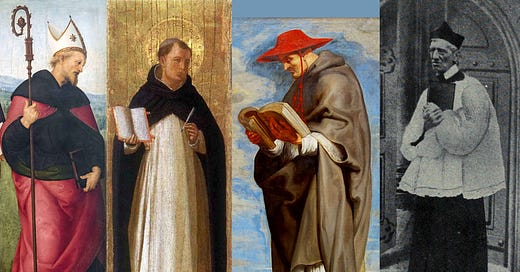Great Catholic Theologians in Defense of Divine Design
Catholic Tradition vs. Darwinian Dogma, Part 3 (conclusion)
In the first two posts, I summarized the teaching of the Bible and the supporting insights of Aristotle. What I have outlined so far on the teaching of Scripture and the understanding of chance and contingency is no different from the teaching we find in all the great Catholic theologians. I will look at four especially notable figures: St. Augustine (354–430), St. Bonaventure (1221–1274), his almost exact contemporary St. Thomas Aquinas (1225–1274), and nearer to our times, St. John Henry Newman (1801–1890).
St. Augustine of Hippo
Augustine wrestles in Book X of the Confessions with the question of God’s nature:
I put my question [“But what is my God?”] to the earth. It answered, “I am not God,” and all things on earth declared the same. I asked the sea and the chasms of the deep and the living things which creep in them, but they answered, “We are not your God. Seek what is above us.” … I spoke to all the things that are about me, and all that can be admitted through the door of the senses, and I said, “Since you are not my God, tell me about him. Tell me something of my God.” Clear and loud they answered, “God is he who made us.” I asked these questions simply by gazing at these things, and their beauty was all the answer they gave.
Augustine is here the very model of the honest seeker that the Book of Wisdom admonishes us to be—one who, sensing God’s works, understands them to be made, and proceeds to venerate their maker. Later in the same discussion Augustine explains why it is that the “answer” given by all these things does not speak aloud to everyone:
Surely everyone whose senses are not impaired is aware of the universe around him? Why, then, does it not give its same message to us all? The animals, both great and small, are aware of it, but they cannot inquire into its meaning because they are not guided by reason, which can sift the evidence relayed to them by their senses. Man, on the other hand, can question nature. He is able to catch sight of God’s invisible nature through his creatures, but his love of these material things is too great. … Nor will the world supply an answer to those who question it, unless they also have the faculties to judge it. … It would be nearer the truth to say that it gives an answer to all, but it is only understood by those who compare the message it gives them through their senses with the truth that is in themselves. For truth says to me, “Your God is not heaven or earth or any kind of bodily thing.”
St. Bonaventure
Augustine’s insight that the world gives answer to all who are prepared to listen, is developed with Franciscan enthusiasm by St. Bonaventure:
All creatures, whether they are viewed in terms of their defects or in terms of their perfectibility, in voices most loud and strong, cry out the existence of God whom they need because of their deficiency and from whom they receive their completion. Therefore, in accordance with the greater or lesser degree of fullness which they possess, some cry out the existence of God with a loud voice; others cry out yet louder; while still others make the loudest cry.1
What kind of a man is it who can hear these cries? Bonaventure tells us in his work The Mind’s Journey into God: “All creatures in this visible world lead the spirit of the contemplative and wise man into the eternal God.”2 Bonaventure means us to take him at his word: God is really known in and through creatures themselves, in whom his signature is inscribed. “It must be said that as the cause shines forth in the effect, and as the wisdom of the artificer is manifested in his work, so God, who is the artificer and cause of the creature, is known through it.”3
Keep reading with a 7-day free trial
Subscribe to Tradition and Sanity to keep reading this post and get 7 days of free access to the full post archives.





